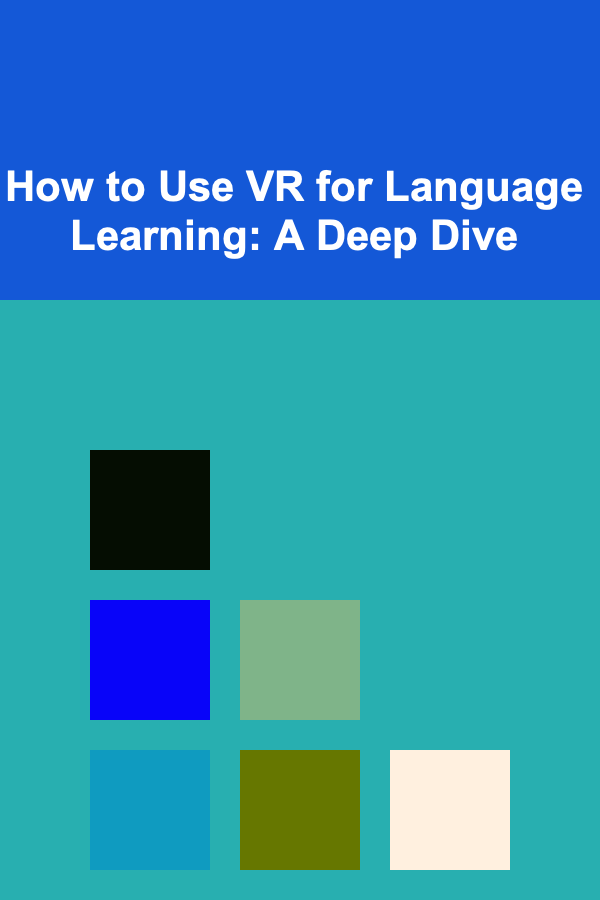
How to Use VR for Language Learning: A Deep Dive
ebook include PDF & Audio bundle (Micro Guide)
$12.99$10.99
Limited Time Offer! Order within the next:

Virtual Reality (VR) is rapidly transforming various sectors, and education is no exception. Its immersive and interactive nature presents a compelling opportunity to revolutionize language learning, offering learners experiences that transcend the limitations of traditional classrooms. This article explores the potential of VR in language acquisition, examining its advantages, practical applications, challenges, and future prospects.
The Unique Advantages of VR for Language Learning
Traditional language learning methods often rely on rote memorization, textbooks, and limited opportunities for real-world application. VR addresses these shortcomings by creating immersive and engaging environments that foster deeper learning and more effective communication. Here are some of the key advantages VR offers:
1. Immersion and Contextual Learning
VR places learners directly into realistic simulations of everyday situations. Instead of passively reading about ordering food in a restaurant, learners can experience ordering food in a virtual Parisian bistro. This contextual learning significantly enhances comprehension and retention. The learner is forced to use the language in a natural, communicative setting, making the experience far more impactful than textbook exercises.
For example, imagine learning Spanish and being placed in a virtual market in Mexico City. The sights, sounds, and even the smells (if olfactory feedback is integrated) create a rich sensory experience that aids in vocabulary acquisition and cultural understanding. Learners can practice asking for prices, negotiating with vendors, and ordering specific items -- all within a safe and controlled environment.
2. Enhanced Engagement and Motivation
Let's face it: traditional language learning can be tedious. VR, on the other hand, offers a level of engagement rarely seen in conventional methods. The interactive nature of VR environments keeps learners actively involved and motivated to learn. Games, simulations, and interactive stories can transform the learning process into an enjoyable and rewarding experience. This increased engagement leads to longer study sessions and a stronger desire to improve.
Think of learning Japanese and participating in a virtual tea ceremony. The visual beauty of the environment, the precise movements required, and the structured conversation all contribute to a highly engaging and memorable learning experience. This type of immersive activity significantly boosts motivation and makes language learning feel less like a chore and more like an adventure.
3. Reduced Anxiety and Increased Confidence
Many language learners struggle with anxiety related to speaking in front of others, especially native speakers. VR provides a safe space to practice without the fear of judgment. Learners can experiment with language, make mistakes, and receive feedback in a comfortable environment. This helps build confidence and reduces the psychological barriers that often hinder language acquisition.
For instance, imagine practicing a job interview in English within a VR simulation. The learner can interact with a virtual interviewer, answering questions and receiving immediate feedback on their pronunciation and grammar. This repeated practice in a low-stakes environment can significantly reduce anxiety and prepare the learner for real-world interviews.
4. Personalized Learning Experiences
VR allows for highly personalized learning experiences tailored to individual needs and learning styles. VR applications can track learner progress, identify areas of weakness, and adjust the difficulty level accordingly. This personalized approach ensures that learners are constantly challenged and supported, maximizing their learning potential. Furthermore, VR experiences can be customized to reflect specific interests and goals, making the learning process more relevant and engaging.
Consider a VR application that teaches Italian. The application could assess the learner's initial vocabulary and grammar skills and then tailor the content to focus on specific areas of weakness. If the learner is interested in cooking, the application could provide scenarios involving virtual Italian kitchens and recipes, allowing them to learn relevant vocabulary and phrases in a context that is both engaging and personally meaningful.
5. Opportunities for Experiential Learning
VR facilitates experiential learning by allowing learners to actively participate in simulated real-world scenarios. This hands-on approach is far more effective than passive learning methods. Learners can develop practical skills, problem-solving abilities, and a deeper understanding of the target culture through these interactive experiences.
Imagine learning about environmental conservation in Spanish by virtually exploring a rainforest in Costa Rica. The learner can interact with virtual scientists, collect data, and learn about the local flora and fauna. This type of experiential learning not only improves language skills but also fosters a deeper understanding of the subject matter.
Practical Applications of VR in Language Learning
The potential applications of VR in language learning are vast and diverse. Here are some specific examples of how VR can be used to enhance language acquisition:
1. Virtual Tourism and Cultural Immersion
VR allows learners to "travel" to different countries and experience different cultures without leaving their homes. They can explore famous landmarks, interact with virtual locals, and learn about cultural customs. This virtual tourism provides a rich and immersive experience that fosters cultural understanding and motivates language learning. It's much more engaging than simply reading about a place in a textbook or watching a documentary.
For example, a student learning French could virtually visit the Louvre Museum in Paris, explore the art collections, and listen to audio guides in French. They could also interact with virtual visitors and practice their conversational skills. This immersive experience provides a valuable cultural context for language learning and makes the process more enjoyable and memorable.
2. Role-Playing and Simulated Conversations
VR allows learners to participate in realistic role-playing scenarios, practicing conversations with virtual characters in various situations. These scenarios can be tailored to specific learning objectives, such as ordering food, asking for directions, or conducting business meetings. The interactive nature of these simulations provides valuable practice in real-world communication.
Imagine a student learning Mandarin Chinese practicing a negotiation with a virtual vendor in a Beijing market. The VR environment provides realistic visual and auditory cues, and the virtual vendor responds to the student's input in real-time. This type of interactive role-playing provides valuable practice in negotiation skills and improves fluency in Mandarin.
3. Virtual Classrooms and Collaborative Learning
VR can create virtual classrooms where learners from different locations can interact with each other and with instructors in a shared virtual environment. This facilitates collaborative learning and provides opportunities for learners to practice their language skills with native speakers and other learners from around the world. Virtual classrooms can also offer access to resources and learning materials that are not available in traditional classrooms.
For example, a student in New York learning German could participate in a virtual class with students in Berlin and an instructor in Vienna. The students could work together on collaborative projects, practice their conversational skills, and receive feedback from the instructor. This virtual classroom provides a rich and engaging learning environment that transcends geographical boundaries.
4. Language Learning Games and Gamified Experiences
VR is ideal for creating language learning games that are both fun and educational. These games can incorporate elements of gamification, such as points, badges, and leaderboards, to motivate learners and keep them engaged. VR games can also provide immediate feedback on learner performance, helping them to identify areas for improvement.
Consider a VR game that teaches English vocabulary. The game could require players to identify objects in a virtual room and label them with the correct English words. As players progress through the game, the difficulty level could increase, introducing new words and challenging them to use the vocabulary in context. This type of gamified experience makes language learning more enjoyable and effective.
5. Vocabulary Acquisition and Memory Enhancement
VR can be used to create immersive environments that aid in vocabulary acquisition and memory enhancement. By associating new words with visual and sensory experiences, VR helps learners to form stronger and more lasting memories. The interactive nature of VR also allows learners to actively engage with new vocabulary, reinforcing their understanding and retention.
For example, a student learning Spanish could use a VR application to explore a virtual apartment. As they move through the apartment, they can interact with different objects and hear the corresponding Spanish words pronounced. They can also participate in interactive exercises that test their knowledge of the vocabulary. This immersive and interactive experience helps them to learn and remember new words more effectively.
Challenges and Considerations
While VR offers immense potential for language learning, there are also several challenges and considerations that need to be addressed:
1. Cost and Accessibility
VR hardware and software can be expensive, making it inaccessible to many learners, especially those in developing countries. Furthermore, access to reliable internet connectivity is essential for many VR applications. Addressing these issues of cost and accessibility is crucial for ensuring that VR-based language learning is available to everyone.
2. Technical Requirements and Digital Literacy
Using VR requires a certain level of technical proficiency. Learners need to be able to set up and operate VR headsets, navigate virtual environments, and troubleshoot technical issues. Educators also need to be trained on how to effectively integrate VR into their teaching practices. Addressing these technical requirements and promoting digital literacy are essential for the successful implementation of VR in language learning.
3. Content Development and Quality Control
The quality of VR content is critical for effective language learning. VR applications need to be well-designed, engaging, and pedagogically sound. They also need to be linguistically accurate and culturally sensitive. Ensuring the quality of VR content requires careful planning, expert design, and rigorous testing.
4. Motion Sickness and User Comfort
Some users may experience motion sickness when using VR, especially during prolonged sessions. This can be a significant barrier to adoption. VR developers need to focus on creating comfortable and user-friendly experiences that minimize the risk of motion sickness. Providing adjustable settings and breaks during VR sessions can also help to mitigate this issue.
5. Integrating VR into Existing Curricula
Successfully integrating VR into existing language learning curricula requires careful planning and collaboration between educators, developers, and policymakers. VR applications need to be aligned with learning objectives, integrated into lesson plans, and assessed effectively. This integration requires a holistic approach that considers the needs of both learners and educators.
Future Prospects and Emerging Trends
The future of VR in language learning is bright, with several emerging trends promising to further enhance the learning experience:
1. Advancements in VR Technology
Ongoing advancements in VR technology, such as higher resolution displays, improved tracking systems, and more realistic haptic feedback, will make VR experiences even more immersive and engaging. These advancements will allow learners to interact with virtual environments in more natural and intuitive ways.
2. Integration of Artificial Intelligence (AI)
The integration of AI into VR applications will enable more personalized and adaptive learning experiences. AI-powered tutors can provide individualized feedback, track learner progress, and adjust the difficulty level accordingly. AI can also be used to generate realistic and responsive virtual characters that can engage in natural conversations with learners.
3. Development of More Accessible and Affordable VR Solutions
The development of more accessible and affordable VR solutions, such as mobile VR headsets and cloud-based VR platforms, will make VR-based language learning more widely available. These solutions will allow learners to access VR experiences from anywhere with an internet connection, reducing the barriers to adoption.
4. Focus on Collaborative and Social VR Experiences
The increasing focus on collaborative and social VR experiences will allow learners to interact with each other and with native speakers in shared virtual environments. These experiences will provide valuable opportunities for learners to practice their language skills in real-world contexts and build intercultural understanding.
5. Increased Research and Development
Continued research and development in VR-based language learning will lead to the development of more effective and evidence-based learning strategies. This research will help to identify best practices for using VR in language learning and inform the design of future VR applications.
Conclusion
VR holds immense potential to revolutionize language learning by providing immersive, engaging, and personalized experiences that transcend the limitations of traditional methods. While challenges remain in terms of cost, accessibility, and content development, the ongoing advancements in VR technology and the increasing focus on research and development promise to overcome these obstacles. As VR becomes more affordable and accessible, it is poised to play an increasingly important role in language education, transforming the way we learn and communicate with the world.
By embracing the power of VR, educators and learners alike can unlock new possibilities for language acquisition and foster a deeper understanding of different cultures and perspectives. The future of language learning is undoubtedly intertwined with the immersive and interactive world of Virtual Reality.

How to Make Money Online as a Social Media Manager: 10 Actionable Ideas
Read More
How to Make the Most of Commuting Time for Busy Dads
Read More
The Chief Operating Officer's Guide: Leading Operational Excellence
Read More
How to Understand the Role of Voice Acting in Games
Read More
Mastering Video Marketing Strategy: A Comprehensive Guide
Read More
How to Set Financial Goals When You're Overwhelmed
Read MoreOther Products

How to Make Money Online as a Social Media Manager: 10 Actionable Ideas
Read More
How to Make the Most of Commuting Time for Busy Dads
Read More
The Chief Operating Officer's Guide: Leading Operational Excellence
Read More
How to Understand the Role of Voice Acting in Games
Read More
Mastering Video Marketing Strategy: A Comprehensive Guide
Read More